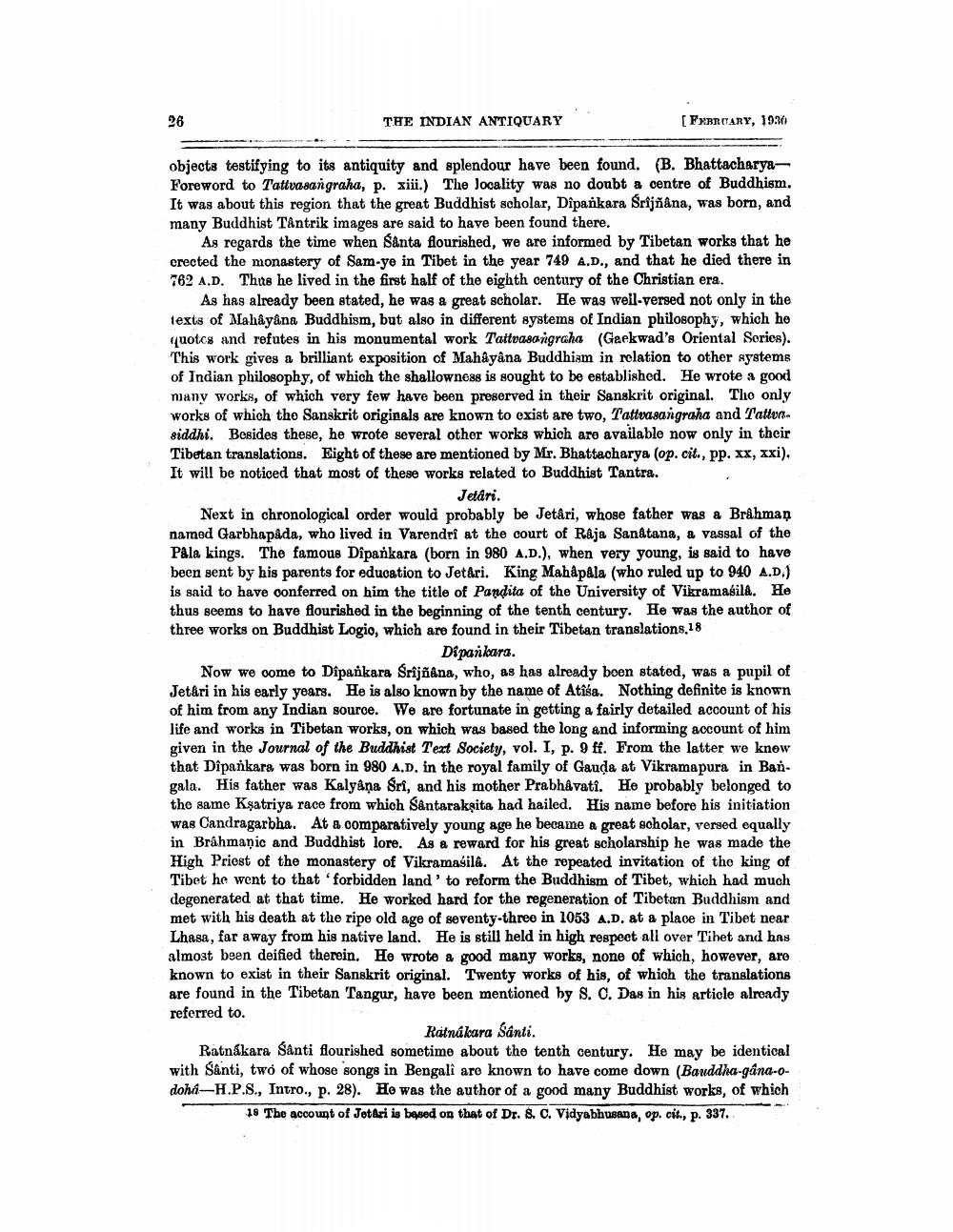________________
26
THE INDIAN ANTIQUARY
(FEBRUARY, 1930
objects testifying to its antiquity and splendour have been found. (B. Bhattacharya Foreword to Tattvasangraha, p. xiii.) The Jocality was no doubt a centre of Buddhism, It was about this region that the great Buddhist scholar, Dipankara Srijñana, was born, and many Buddhist Tantrik images are said to have been found there.
As regards the time when Santa flourished, we are informed by Tibetan works that he crected the monastery of Sam-ye in Tibet in the year 749 A.D., and that he died there in 762 A.D. Thus he lived in the first half of the eighth century of the Christian era.
As has already been atated, he was a great scholar. He was well-versed not only in the texts of Mahayana Buddhism, but also in different systems of Indian philosophy, which he quotes and refutes in his monumental work Tattvasangraha (Gaekwad's Oriental Sories). This work gives a brilliant exposition of Mahayana Buddhism in relation to other systems of Indian philosophy, of which the shallowness is sought to be established. He wrote a good many works, of which very few have been preserved in their Sanskrit original. Tho only works of which the Sanskrit originals are known to exist are two, Tattvasangraha and Tatten. siddhi. Besides these, he wrote several other works which are available now only in their Tibetan translations. Eight of these are mentioned by Mr. Bhattacharya (op. cit., pp. xx, xxi). It will be noticed that most of these works related to Buddhist Tantra.
Jetari. Next in chronological order would probably be Jetåri, whose father was a Brahman named Garbhapada, who lived in Varendri at the court of Raja Santana, a vassal of the Pala kings. The famous Dîpankara (born in 980 A.D.), when very young, is said to have been sent by his parents for education to Jet&ri. King Mahapala (who ruled up to 940 A.D.) is said to have conferred on him the title of Pandita of the University of Vikramasild. He thus seems to have flourished in the beginning of the tenth century. He was the author of three works on Buddhist Logio, which are found in their Tibetan translations.18
Dipankara. Now we come to Dipankara Srijñana, who, as has already boen stated, was a pupil of Jetári in his early years. He is also known by the name of Atisa. Nothing definite is known of him from any Indian souroe. We are fortunate in getting a fairly detailed account of his life and works in Tibetan works, on which was based the long and informing account of him given in the Journal of the Buddhist Text Society, vol. I, p. 9 ff. From the latter we know that Dipankara was born in 980 A.D. in the royal family of Gauda at Vikramapura in Ban. gala. His father was Kalyana Sri, and his mother Prabhavati. He probably belonged to the same Ksatriya race from which Såntarakṣita had hailed. His name before his initiation was Candragarbha. At a comparatively young age he became a great scholar, versed equally in Brahmanic and Buddhist lore. As a reward for his great scholarship he was made the High Priest of the monastery of Vikramasila. At the repeated invitation of the king of Tibet he went to that forbidden land' to reform the Buddhism of Tibet, which had much degenerated at that time. He worked hard for the regeneration of Tibetan Buddhism and met with his death at the ripe old age of seventy-three in 1053 A.D. at a place in Tibet near Lhasa, far away from his native land. He is still held in high respect all over Tihet and has almost been deified therein. He wrote a good many works, none of which, however, are known to exist in their Sanskrit original. Twenty works of his, of which the translations are found in the Tibetan Tangur, have been mentioned by S. C. Das in his article already referred to.
Ratnákara Santi. Ratnákara Sånti flourished sometime about the tenth century. He may be identical with Sânti, two of whose songs in Bengali are known to have come down (Bauddha-gana-odoha-H.P.S., Intro., p. 28). He was the author of a good many Buddhist works, of which
18 The account of Jetari is based on that of Dr. 8. C. Vidyabhusana, op. cit., p. 337.




